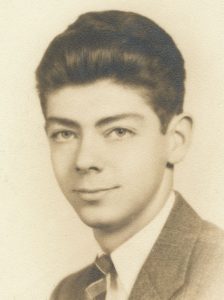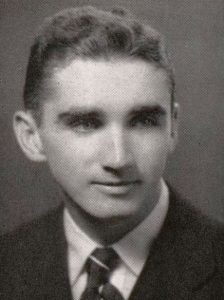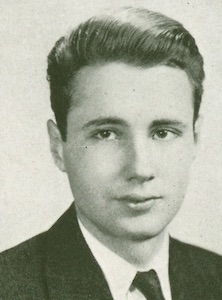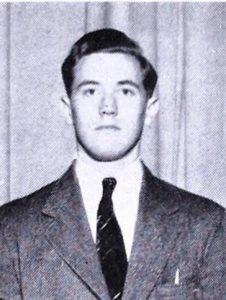The Muhlenberg Memories Project
From the Mail Bag:
Action in the Air, on the Land and on the Sea
Wilmer Cressman ‘42 wrote about events in the Pacific once the censors gave him permission. “Sometime has elapsed since I last wrote, but we were a bit busy as you can see from the enclosed details. A report from the Pacific areas by your personal correspondent:
For one operation the bars have been let down enough for me to give you a general idea, at least, of Pacific amphibious warfare. Our work-horse of a ship was one of the many ships participating in the initial landings of Leyte island in the Philippines.
Before actual landing could be made, however, it meant entering Leyte Gulf through a narrow channel in the middle of the pitch-black night with a haze lying low on the water. An occasional mine floating by made the dash still more interesting.
We were operating on a railroad time table from the very beginning and ahead of us were other units already making the approach, since there were to be several beachheads established simultaneously. As the sun broke through the mist over the islands forming the entrance to the Gulf a flight of TBF’s, bearing the familiar white star, was a most reassuring sight — the air was ours, always a good start.
Beach areas were ringed by major warships, throwing broadside after broadside of high explosives into beach defenses. It was a saturating shelling designed to cover every inch of the ground marked out on our charts as landing areas. Mine sweeps had already cleared away any mine fields. Drifting over the fire support areas were clouds of yellowish smoke, which kept growing heavier as another flash and a mighty rumble marked the beginning of another broadside.
The hour of landing was a most convenient one in the middle of the morning allowing the nips to get a full breakfast, if they were able to eat at all, seeing the flock of ships pouring down on their ill-gotten island. Fifteen minutes before H-hour saw the most concentrated bombardment I’ve ever seen in the Pacific. From the miles out it was like the constant rumble of summer thunder. Going in ahead of the assault waves were landing craft hurling rockets by the hundreds into an area only a few miles long. A cloud of smoke nearly obscured the beach which seemed to erupt in a mess of earth, sand, palm trees, fortifications, and Japs. Naval aircraft were over the area dropping their eggs unmolested.
On the scheduled minute, the firing lifted and the assault waves poured ashore against minimum opposition. The bombardment, plus air strikes, had pushed the Nips from the beach and on schedule all troops landed, securing the Beachhead in a matter of hours. The Nips came back with rather heavy mortar fire, but there was no stopping us. Without qualification it was the most perfect timing and teamwork I’ve yet seen in an amphibious operations, and this was by no means my first” (18 November 1944).


Warren Himmelberger ’43 wrote on 26 September 1945 about his whereabouts in the China operations where Admiral Kinkaid led the way into Jinsen harbor for the Korea operation. “We had spent a week or two steaming around the Yellow Sea, going past such places as Tsingtao, Dairen, Port Arthur, and Chingwangtao in battle formation. That part of the trip was mostly to show off our fleet, I imagine. Our force consisted of the four heavy cruisers of the Indianapolis class, the two new battle cruisers Guam and Alaska, and half a dozen destroyers” (September 26, 1945).

C. L. “Roy” Carter, in a letter about striking Japan’s mainland, wrote, “We struck Tokyo on July 10 and then went north to Hakkaido to strike up there twice. We then went south again. We lingered around the Jap coast and struck Tokyo for 2 days. We dodged typhoons for a while then went further south to hit Kobe and Kuri Naval Bases. We struck for 3 days before going back to Hokkaide. We bombarded and struck Hokkaide for a couple of days and nights. Our task group which included the South Dakota, Bennington and Yorktown and others operated with another task group (38.2) and also a small detachment of the British fleet. We went south again to hit Tokyo Bay and it was on our second day of striking that we got news of the war’s end. We called our strike back to the ship but even after they returned, we were attacked by 4 Jap suicide bombers which were shot down. We spent some uneasy nights wondering if we’d be attacked again” (11 November 1945).
Robert G. Hale ‘45 writes a letter revealing an insider’s perspective about Japanese suicide—kamikaze, “You can call this a “now it can be told” letter if you wish because if I remember correctly the last time I wrote I was somewhat hampered by the restricting arms of censorship. That was during the Okinawan campaign, a campaign in which our boys turned in a creditable performance – especially that marines and army men who took such staggering losses in the close fighting. Already as I write planes are crowding the airways, flying from new won positions on Okinawa against the Jap and his homeland industry. So we feel bad about our losses but we know they were not in vain. The Jap is paying scorefold.
The part of the war that I saw was of course, strictly Navy. The Japs racked their feeble minds to develop new ways to commit suicide, an art of which they do surpass us. I saw their “Kamikaze” men come in – 9 of 10 were suicides and the 10th one was the won who changed his mind about dying. Day after day we wrote – not my ship, the Navy as a whole – these Japs off the lists of sons-of-heaven. A lot of our ships got hit. You read about that. Our little rescue ship plowed out to do what we could every time another ship was hit. It got so that other ships hated to see us hovering around because they knew by nature of our job that we looked for trouble. I’m sure glad for once that we outlived our usefulness off the shores of Okinawa. Things are now well under control. We never were lucky. A couple of times I think the Jap flipped a coin = but he choose the other ship each time. Then came the end of this, our little episode, when one day they told us to head her bow back to a near area and take in some rest, recreation and rehabilitation. Who are we to refuse? Ours was not to reason why. So here we ride as anchor in a rear area where we don’t search the skies 34 hrs a day for the Nippon, where one can see a full movie without the interruptions of air raids, where we have no worries except to invent methods of resting, recreating and rehabilitating – whatever that is. we have seen some rest, tangible (?), flesh and blood women though, Army and Navy nurses. This in its isolated self is a boon to morale.
Well, I’ve just about run the gambit of my gassing for today, so with two pages just about chock a block with scribbling I’ll throw in the towel til another time. Expecting to hear from you soon. Good luck – best regards to all at their jobs back there” (15 July 1945).

In a post-Christmas note, Lt. Jack H. Blair III ‘38 sent thanks and updates. “The Gona-Buma area is cleared of all Japs. It was all jungle fighting. People in the States will never realize what their boys went through to capture and then hold these strategic points. At this writing the enemy is ‘putting all out’ to land supply and reeinforcements [sic] at Lae.
“I have a fine platoon of fighting men.
“There are a couple fellows from Pa._ from in and around vicinity of Pittsburg. Each and every man can handle four or five weapons with great accuracy. They land in trees and think nothing of it. I hit same over here as I did in the States – like a ton of bricks! Still am walking away – therefore, saying goes, ‘perfect landings’.
“Thanking you again for your kind remembrance. I now say good-bye with best of regards to all” (13 January 1943).


